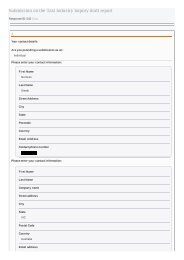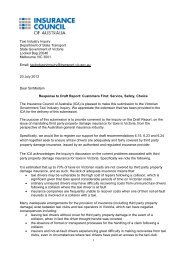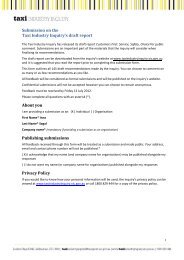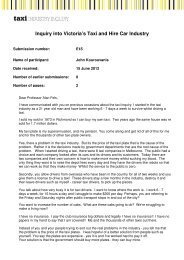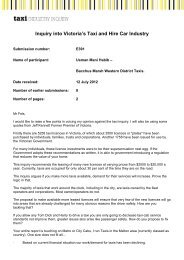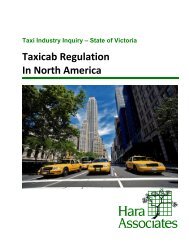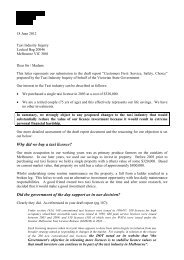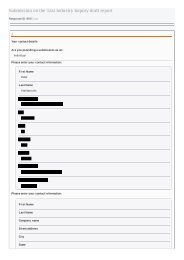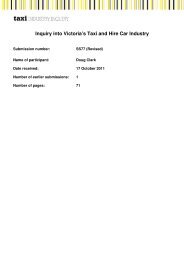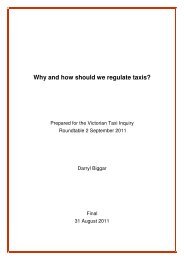Part D â Understanding and improving industry performance (PDF ...
Part D â Understanding and improving industry performance (PDF ...
Part D â Understanding and improving industry performance (PDF ...
You also want an ePaper? Increase the reach of your titles
YUMPU automatically turns print PDFs into web optimized ePapers that Google loves.
Opportunities with new technology<br />
New technology, particularly the use of GPS-enabled<br />
smartphone applications to book taxis may have the<br />
potential to undermine the 10 per cent service fee. New<br />
smartphone apps with payment functions potentially<br />
also enable the transfer of payment from a passenger’s<br />
account to a driver’s (or operator’s) account, bypassing<br />
the need for non-cash payment instruments or their<br />
associated payment processing systems (see case<br />
study). Of course, it will still be possible for a surcharge to<br />
be applied to a fare irrespective of how payment is made,<br />
but using these new applications may at least ensure that<br />
the bulk of any surcharge finds its way to those providing<br />
the service.<br />
While it is difficult to predict how these developments<br />
may affect the taxi <strong>industry</strong> in the future, the inquiry is<br />
concerned to ensure that regulation does not st<strong>and</strong> in the<br />
way of technology <strong>improving</strong> competition in the payments<br />
processing market. 2526<br />
12.5. Reform options<br />
The inquiry is concerned that consumers pay excessive<br />
fees for processing electronic payments of taxi fares.<br />
The significant market power historically exercised<br />
by Cabcharge in setting its 10 per cent service fee<br />
appears to act as a ‘marker’ for other payments<br />
service providers. This is a particular concern in<br />
relation to general bank issued or third party payment<br />
instruments, given that average surcharges applied by<br />
merchants in other sectors are between one <strong>and</strong> four<br />
per cent. However, the complexity of the operation<br />
<strong>and</strong> regulation of payment systems, the prevailing<br />
market characteristics <strong>and</strong> the uncertain impact of<br />
technology all need to be considered carefully when<br />
considering options to deal with this problem.<br />
Case study<br />
Technology <strong>and</strong> fares<br />
Alternatives to using taxi-specific or third party payment instruments are beginning to emerge. The inquiry is<br />
aware of at least one application, ingogo, that enables taxi users in Sydney to hail a cab <strong>and</strong> pay the fare using<br />
a smartphone. ingogo has developed a safe payment function that uses a four digit payment code to protect a<br />
passenger’s credit card details. Customers download the free ingogo app, load their credit card details <strong>and</strong> enter<br />
a four digit payment code. At the end of the trip, customers check the fare entered by the driver is correct, enter<br />
the code to authorise payment <strong>and</strong> receive a receipt via email. The fare is deposited the next business day into the<br />
driver’s bank account.<br />
ingogo advertise a lower booking fee for using the app <strong>and</strong> an eight per cent credit card charge, claiming that<br />
customers can save 4.7 per cent on an average cab fare. 25<br />
The Australian Taxi Drivers Association advised the inquiry that it is working with TAXIS (also currently only<br />
operating in Sydney) to offer ‘an alternative job offer <strong>and</strong> payment system’ to drivers at any time that also reduces<br />
costs to passengers. TAXIS also offer registered users the ability to pay a cab fare using a web-enabled mobile<br />
phone, without presenting a credit card. The Association observes that “this action by taxi drivers themselves<br />
has the potential to fundamentally reshape the <strong>industry</strong> by re-directing cash flows from the monopolistic <strong>and</strong><br />
anticompetitive bodies now dominant”. 26<br />
25 See www.ingogo.mobi<br />
26 ATDA, Op. Cit., p.4<br />
260




